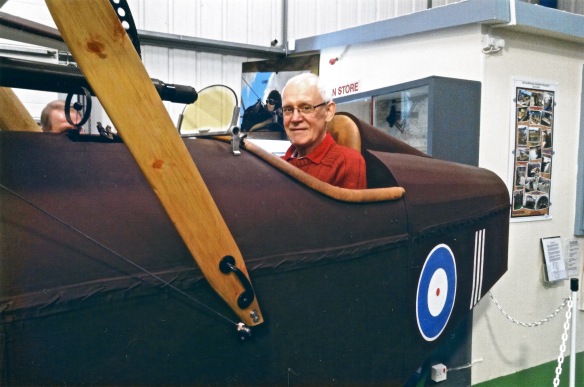From my brother, Chris’s, research, I have learned that my potential great uncle, Fred Evans, brother of great uncle John (Jack Riskit) and Grandma Hunter, née Evans, was killed on the Somme in 1916. A first class cricketer and footballer, Fred was expected to play cricket for Lancashire until the war put a stop to it. From his home in Sydney, a member of the 53rd Bn., Australian Infantry, he set out for France on 8th March, 1916, and was, according to a comrade, George Stone, one of the first over the parapet and shot “about half-way across to” the German line, on 19th July. He has no known grave and is commemorated at V.C. Corner Australian Cemetery Memorial, Fromelles.


My Grandparents, John Francis Cecil (Jack) Knight, wearing Army uniform in 1917; and George Henry Hunter, clad in Merchant Navy uniform, were both fortunate enough to – at least physically – to have survived WWI, the first time the world went mad.
All I know about Jack’s war service is that he taught airmen to fly. His qualification for this was

The Norwood School for the Sons of Gentlemen, which was a family run business of the Knights for several generations, although not always in West Norwood. He may not have known how to fly, but he did know how to teach. Male members ran the school, whilst the women became governesses when they served all over Europe. Central to the photograph, probably taken in 1913, are my paternal grandparents Beatrice and Jack (John Francis Cecil) Knight.
The woman on the far left we knew in later years as Auntie Evelyn. It was her sister, Mabel, who bequeathed our father 18 Bernard Gardens. When the family moved into this large house in Wimbledon, among Mabel’s effects were all the gramophone records of Julie Andrews. Mabel had no record player, but had clearly taken pride in her former charge. The colourful careers of our three great aunts will feature further on in the story.

Here, our late brother, Chris, on a visit to Tangmere, occupies a replica of the SE 5a Scout from 1918, which our grandfather taught airmen to fly. From the museum web page we read:
‘SE5A COCKPIT REPLICA
The Royal Aircraft Factory SE 5a scout was one of the most successful British fighter aircraft of the First World War and was one of the first aircraft to fly from the newly created RAF Tangmere in 1918 when No 92 Squadron trained here before leaving for the Western Front. The Museum’s replica was built to mark the centenary of the outbreak of the First World War and constructed by a small team drawn from our engineering staff using original drawings and employing the same techniques that were used for the original aircraft’.
Jack, after 1914, was never to work in the school again. Returning from the First World War he no longer had the heart to work inside or in education, and bought a removal firm.
Grandpa Hunter was a land based engineer, almost certainly using his skills as a turner. He served on Victory 2, a training depot for RN divisions at Crystal Palace.


